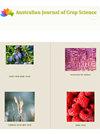Photosynthetic light response curves in Eucalyptus benthamii and Eucalyptus dunnii clones
Q3 Agricultural and Biological Sciences
引用次数: 0
Abstract
The photosynthetic light-response curve reflects the instantaneous response of the net photosynthetic rate to different gradients of photosynthetically active radiation. Genetic materials can respond differently to light and consequently alter productivity. Thus, this work aimed to compare clones of Eucalyptus benthamii and Eucalyptus dunnii by checking the CO2 assimilation rate due to the increase in photosynthetically active radiation. The evaluations were carried out in mini-stumps implanted in a clonal mini-garden system. The CO2 assimilation rate curves were determined with the aid of a portable photosynthesis meter. The curves of CO2 assimilation rate (A) in response to the increase in photosynthetically active radiation (PAR) were evaluated at values of 1500, 1000, 700, 450, 250, 120, 50 and 0 μmol m-2 s-1 for clones of E. benthamii and E. dunnii. The three Eucalyptus clones evaluated showed a similar behavior of the A/PAR curve, showing a high demand for photosynthetically active radiation. In general, the three clones were very similar in terms of CO2 assimilation rate due to the increase in photosynthetically active radiationbenthamii桉和dunniii桉无性系的光合光响应曲线
光合光响应曲线反映了净光合速率对不同光合有效辐射梯度的瞬时响应。遗传物质对光的反应不同,从而改变了生产力。因此,本研究旨在通过检查光合有效辐射增加导致的CO2同化速率来比较本胺桉和敦尼桉的无性系。在无性系微型园林体系中进行了微型树桩的评价。利用便携式光合作用仪测定CO2同化速率曲线。测定了在1500、1000、700、450、250、120、50和0 μmol m-2 s-1处理下,底栖e和dunnii无性系CO2同化率(A)随光合有效辐射(PAR)增加的变化曲线。3个桉树无性系在a /PAR曲线上表现出相似的行为,对光合有效辐射有较高的需求。总的来说,由于光合有效辐射的增加,三个无性系在CO2同化率方面非常相似
本文章由计算机程序翻译,如有差异,请以英文原文为准。
求助全文
约1分钟内获得全文
求助全文
来源期刊

Australian Journal of Crop Science
农林科学-农艺学
CiteScore
1.20
自引率
0.00%
发文量
75
审稿时长
3.5 months
期刊介绍:
Information not localized
 求助内容:
求助内容: 应助结果提醒方式:
应助结果提醒方式:


